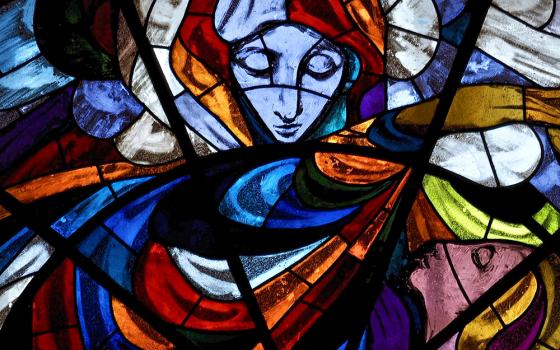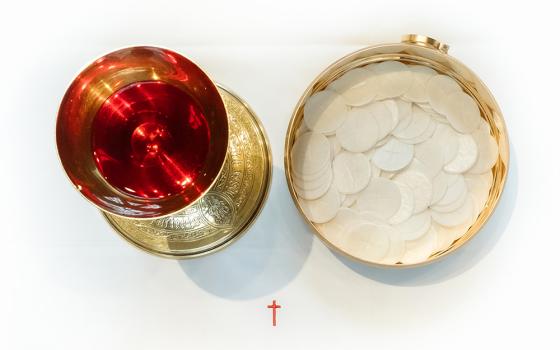If you are presiding at the liturgy on January 1, try this: Ask the assembly what we are celebrating today. Most people will look at you as if you just emerged from hibernation. Then, the person who does the introduction at the liturgy will tell you that today is the Solemnity of The Blessed Virgin Mary, Mother of God. Of course! Isn’t that what everybody celebrates on January 1? Actually, this feast and the new year go together quite well.
- The Lord bless and keep you!
- The Lord let his face shine upon you, and be gracious to you!
- The Lord look upon you kindly and give you peace!
What better way to begin the new year than with this blessing? The Virgin Mother herself probably heard it pronounced over her and her people. How might she have understood her own blessedness?
The summary phrase of the blessing is “The Lord give you peace.” Of course, Mary would have heard the word “shalom” for peace, a word almost exactly replicated by our Muslim brothers and sisters with their word “salaam.” “Shalom” expresses the depth of the concept of peace. The Hebrew shalom means more than peace; it means peace, justice and integrity in relationships. It implies safety and growth in wholeness as if the entire universe was woven together and functioning as God intended. The blessing of shalom prays that humanity and the entire universe may live the communion God created us to enjoy.
Today we celebrate the “Solemnity of the Blessed Virgin Mary, the Mother of God.” That title would have surely overwhelmed the simple woman of Nazareth. But she didn’t have to concern herself with theology, dogma, titles and solemnities. Instead, she had a new baby, a confused but faithful husband and unexpected visitors coming to witness the scene where her family was trying to make do in spite of the inhospitable circumstances in which they found themselves.
What do we know of this young woman? First, we learned that God looked upon her kindly, or in Luke’s words, she had found favor with God. Then, we witnessed her humble self-description: “Here I am, the handmaid of the Lord.” In spite of the inconceivable dimensions of what she had been told, Mary’s response exhibited shalom. She trusted, gave birth to her child and simply cared for him.
When the shepherds appeared on the scene they knew far more than Mary could have expected. Delighted to discover her son in the manger, they started spreading the word as if they understood exactly what was going on. Like many of us, those shepherds were quick to make proclamations about what they thought God was up to in their midst. Like Jesus’ own disciples, these first witnesses may well have had the right vocabulary, but it’s highly unlikely that they fully comprehended what they had encountered. The shepherds talked, others were “amazed,” and we don’t hear a single word from Mary.
Luke tells us that “Mary kept all these things, reflecting on them in her heart.” Her name would be remembered in the scriptures of Christianity and Islam. Generations to come would call her blessed, and the Fathers of the Church would defend her title as “Mother of God.” But, from the day of Jesus’ birth until his death, the little we hear from her amounts to no more than one question, a subtle request on behalf of others and a reflection of her own discipleship: “Son, why have you done this to us?” “They have no wine,” and “Do whatever he tells you.”
When Luke tells us that Mary kept things in her heart, the word he uses indicates a long process of mulling, a life of discernment, trying to put together disparate pieces of a mystery. While the process didn’t lead to quick conclusions, it doesn’t mean she gave up on it. Luke’s statement about her ongoing reflection is one of the reasons some conclude that Mary herself gave Luke the Nativity story.
Whether or not the narrative originated with Mary, Luke portrays her as the contemplative in action. Mary had more to ponder than anyone else in this story. She had to question her experience and her response. She had to make sense of all that she had encountered while balancing it with the traditions of her people. She must have accepted living with more questions than answers and far more hope than certainties. In addition to all of that, she had to change the diapers and fix dinner.
Mary, Mother of the God who came in the flesh of a needy infant, learned to remain open to God’s shalom, to allow her faith to exceed her uncertainties and her hope to give her resolve beyond her power to imagine. She sought to do God’s will as she baked their daily bread. We look to the Mother of God to teach us how to live simply as contemplatives in action.
NUMBERS 6:22-27
We begin the new year with this blessing drawn from Israel’s days in the desert. Although the Roman liturgy doesn’t celebrate New Year’s Day as such, the readings for the Solemnity of the Blessed Virgin Mary, Mother of God, are highly adaptable to celebrate New Year’s Day. This reading was chosen for today’s solemnity probably for the connection between the invocation of God’s name and the naming ceremony for the child Jesus in today’s Gospel. But we shouldn’t miss how the use of this reading on the first day of the year invites us to take some prayerful time with the very concept of blessing.
What better way to inaugurate the year than with a blessing?
The Hebrew Scriptures word for blessing, berek, covers a breadth of meaning. In some instances a blessing seems almost magical, as was the case of Jacob who irrevocably stole his brother’s blessing in Genesis 27. Some linguists believe that the word berek is connected to kneeling down, conveying an awareness that blessing comes only from God. When the word berek is translated into Latin and its derivative languages (bendecir in Spanish), it means to speak well of someone, and, by extension, to pray that God look on them with favor.
The blessing formula from the Book of Numbers which we repeat in both liturgy and common prayer has three doublets: asking that God shower one with goodness and mercy (bless and keep), asking for God’s active presence and mercy (face shine upon you, be gracious to you), and finally asking that God be pleased and grant the other with fullness of life and inner harmony (peace).
In the Book of Numbers, this blessing comes at the end of a section concerned about how a frail people could be worthy to live in the presence of God. The solution was a series of cultic rules to help humans adapt to God’s holiness. Paul called that endeavor hopelessly flawed; no amount of human effort can make us worthy. God’s love is a free gift that transforms us into a redeemed people, if we are willing. Therefore, it is particularly apt that the rules for holiness should end with this plea for God’s grace.
We can look to this blessing for at least two sources for our new year prayer. First, it is a reminder that all that is truly good comes to us as a free gift from God. Secondly, as it encourages us to call upon God’s name, it reminds us of everything that the names of God connote. Beginning with the name of Jesus, we realize that every name we have for God points to God’s desire to share blessedness with us.
GALATIANS 4:4-7
This reading, similar to the first for today’s liturgy, while appropriate for the first day of the year, was chosen for its relationship to the feast of Mary the Mother of God. It is worthwhile to pause to consider this oft-controversial title of Mary, Mother of God. Throughout history some considered it a heresy, not to mention an impossibility. At stake in calling Mary “Mother of God” was belief in the unity of Jesus’ human and divine natures.
This title speaks more of Jesus than of Mary. It is a reminder that God’s Son was fully human, born of a particular woman, subject to human frailty and a member of God’s chosen people. The revised translation of the Nicene Creed emphasizes this very particularly with its phrase, “Incarnate of the Virgin Mary.” More than “born of the Virgin Mary,” this translation emphasizes Jesus’ incarnation through the virgin. It reminds us that Mary was an essential part of God’s plan, that the flesh of Jesus came from his mother.
This emphasis might remind us of Sojourner Truth’s interpretation of Incarnation. Addressing a man who explained women’s inferiority based on Christ’s incarnation as a male, Sojourner replied with her “Ain’t I a Woman” speech. Looking at her adversary Sojourner said: “Then that little man … says women can’t have as much rights as men, ‘cause Christ wasn’t a woman! Where did your Christ come from? Where did your Christ come from? From God and a woman! Man had nothing to do with Him.” Although Paul and the translators of the creed were not pleading Sojourner’s cause, they share her respect for the importance of Mary in God’s plan of salvation.
When taken as a whole, this reading leads us beyond Mary to a reflection on the effects of the Incarnation. First, Paul makes a juridical point: Christ became human to ransom all with whom he shared humanity. Then Paul moves beyond the theoretical into the experiential. Not satisfied that his people might believe that they are saved, he wants them to feel the reality of it. He calls on them to be in touch with their own religious experience, their joys and their longings.
As Paul speaks to people who have consciously chosen their Christian identity, he calls them to remember the feeling of their attraction to God through Christ. They are not Christians because they recognized the truth of the faith like a mathematical formula, but rather because God touched their hearts in a very particular way by drawing them to respond as children of God who share Christ’s own relationship with the Father.
The fact that we share this relationship leads to the astounding claim that Christ became human so that humans could become divine (Catechism of the Catholic Church #460). Our divinization is the purpose and the ultimate result of the Incarnation.
LUKE 2:16-21
With this reading we revisit the Gospel we heard on Christmas morning. In keeping with the feast of Mary the Mother of God, we look to what Luke says about her and what that reveals about us and our life. The key line is “Mary kept all these things, reflecting on them in her heart.”
Luke presents us with various responses to Jesus’ birth. The shepherds, having seen the child, become evangelists, revealing what they had seen to an unidentified public who were amazed. Those two responses, proclamation and amazement, anticipate what we will hear throughout the story of Jesus. Some see him and become so convinced that God is working through him that they begin to evangelize, spreading good news that they don’t fully understand. As a result of their proclamation, others respond with “amazement,” or we might say with great curiosity and interest. When the people are amazed, they acknowledge that something is happening, that it might even be something that comes from God, but there’s no commitment involved. They may take a good look but will be quite reluctant to make a public statement about it. As Darrell Bock explains it, “The report tickles the crowd’s ears but it may have missed their hearts” (Luke: Baker Books, 1994).
The last person about whom we hear is Mary, the mother of Jesus. When she was first visited by the angel she did not hesitate to give herself to God’s plan. Now that God’s Word has literally taken flesh through her, it is too much to comprehend. Like Thomas Aquinas who composed the hymn Tantum Ergo to prayerfully acknowledge that reason cannot grasp the ways of God, Mary understood that the mystery taking place was greater than she could explain, much less proclaim. All she could do was ponder as she immersed herself in the daily nurturing of God’s child.
Whether or not Mary was the source for Luke’s narrative, Luke presents Mary as the contemplative in action. The word for keeping these things in her heart is syneterei, a multivalent term that implies that she tried to comprehend disparate events together, that she held interior conversations about it all, that she could treasure all that happened even if she couldn’t explain it. That was an emotional and intellectual response that was both faith-filled and humble. It demonstrated her acceptance of the prophetic teaching that God’s ways are not human ways. Mary strove to believe that God was in charge of it all; lack of comprehension would not keep her from her daily work.
Celebrating this feast renews our observance of Christmas. Celebrating the Mother we celebrate the Son. Celebrating the Son, we celebrate what he offers us: nothing less than the opportunity to share divine life. That’s the mystery that we, like Mary, must ponder deeply and proclaim with joy.
Planning: Mary, Mother of God
By Lawrence Mick
Every year this day presents us with a plethora of potential themes. A primary one, of course, is reflected in the title of the Solemnity: Mary, the Mother of God. So it’s a Marian feast day, the oldest one in the calendar. At the same time, it is important to remember that Mary was declared “Mother of God” as a way of insisting that Jesus was truly God (Council of Ephesus, 431). So, as always, honoring Mary points us to her son.
This focus on Jesus is also reflected in the readings today. The first reading, a beautiful blessing from Numbers, speaks of invoking God’s name in blessing. Then the Gospel ends by noting that the child “was named Jesus, the name given him by the angel before he was conceived in the womb.” This day celebrates the naming of Jesus and his circumcision. The second reading from Galatians also focuses on Jesus as our redeemer who has made us adopted children of God. None of this is a denigration of Mary. Throughout her life, she focused her attention on Jesus, and she wants us to do the same.
This is also, of course, the first day of a new year, which may have priority in the consciousness of many parishioners. There are several ways to tap into that awareness. The main one is to focus on the World Day of Prayer for Peace. This is the 50th year for this observance, so it deserves a little extra attention, especially in light of the year just concluded. You might use the texts from the Mass for the Preservation of Peace and Justice (#30, Masses for Various Needs) if your bishop permits, or you could use one of the prayers from that Mass to conclude the petitions. Several of the petitions might focus on this theme as well. You could also distribute prayer cards with a prayer for peace at the end of Mass. Materials for the World Day of Peace are here: www.usccb.org/issues-and-action/human-life-and-dignity/war-and-peace/world-day-of-peace.cfm
Another way to mark the new year is with a blessing of calendars. If you have parish calendars to distribute, bless them at the end of each Mass and pass them out as people depart. If not, invite people to bring their calendars to be blessed (including cell phones which many people use for calendars today). A blessing prayer for the new year can be found in Catholic Household Blessings and Prayers in part III (p. 86 in the second edition). A more extensive blessing prayer by Fr. Ed Hays can be found in Prayers for the Domestic Church: “New Year’s Blessing Prayer for Clocks and Calendars.” (You can easily chose to adapt it for today’s latest technology.)
A third way to focus on the new year is to use the third solemn blessing in the Missal, titled “The Beginning of the Year,” to conclude Masses today.
Prayers: Mary, Mother of God
By Joan DeMerchant
Introduction
Today’s feast focuses on the role of Mary in the wonderful miracle of the Incarnation. She was closest to all that happened, and it was she who came to know that God is here with, for and among us. As we celebrate this feast of Mary as the Mother of God, we, too, pause to ponder. What does it mean to be the Mother of God? What does this title say about Mary? About God? About us? And about the church that gave her this title? We begin this new year with fascinating questions.
Penitential Act
- Lord Jesus, you came as a gift to us and to the simple shepherds: Lord, have mercy.
- Christ Jesus, your coming was pondered in Mary’s heart: Christ, have mercy.
- Lord Jesus, you came to be with and among us all: Lord, have mercy.
Prayer of the Faithful
Presider Let us turn to the God who comes among us and pray for our needs and the needs of the whole world.
Minister For the church: that we may embody the meaning of God’s presence among all people, we pray:
- For peace in our world, especially where peace is absent or fragile, we pray:
- For those who have forgotten that we are called to be signs of God’s presence, we pray:
- For all mothers and for those who mother us by showing God’s presence in our lives, we pray:
- For mothers or fathers who parent alone or in dangerous situations, poverty or fear, we pray:
- For those without loving parents or assurance that God is with us, we pray:
- For those who need encouragement as we begin a new year, we pray:
- For the sick, the dying and the grieving among us; and for those who have died ... (names) ... we pray:
Presider God who came to live among us, we thank you for those who show us who you are. We thank you especially for the gift of Mary, whom we honor by many titles. Grant us the courage to be signs of your presence to others. We ask this in the name of Jesus, your beloved Son. Amen.
Advertisement




